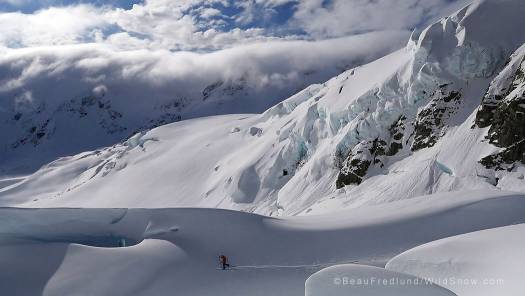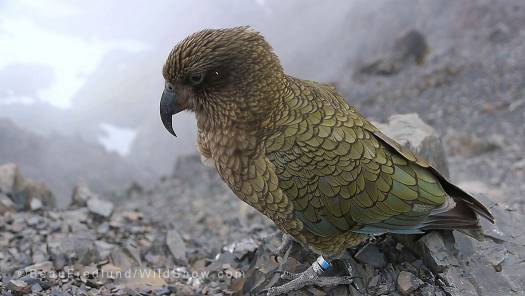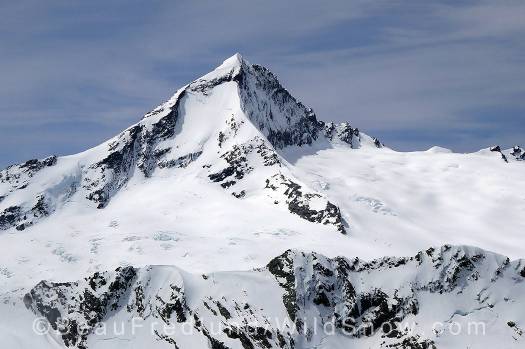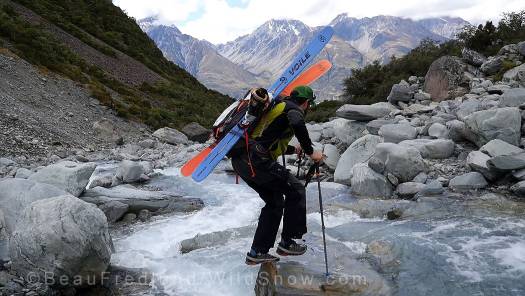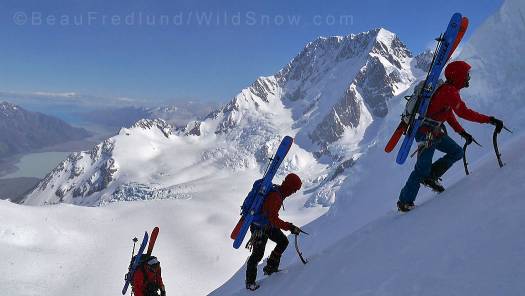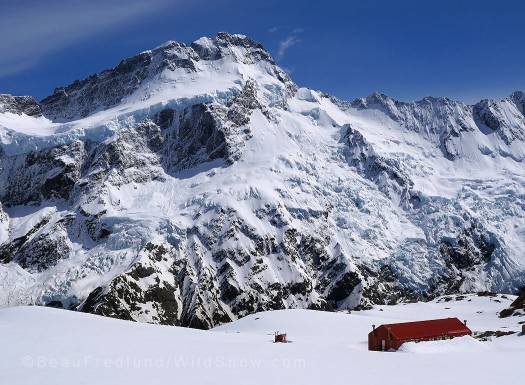
The Mueller Hut, highly recommended. Easy access, spectacular views, and great skiing. Photo: B. Fredlund
Insider tips for your first, or next, New Zealand ski trip
It is always snowing somewhere, and if it’s snowing, somebody is skiing.
I recently caught up with my friend Michael Gottino who had just returned from his first ski trip to New Zealand where winter is full-on. His mind was blown. He found the shear vertical relief of those mountains rising at times almost 10,000 feet above the valley floor to be the most dramatic. “Driving around the country, the valleys could have been taken from many places in Colorado. Then BOOM! There is a huge range of jagged peaks thousands of feet above you.”
On his trip, he found weather and snow conditions to be the biggest obstacles.
“New Zealand had a slow start to the winter and the costal snowpack really threw me for a loop,” he reported. “Bulletproof conditions would give way to huge storms, wind and then a nasty rhyme ice cycle.”
However, the conditions weren’t always trying and Michael was stoked that even on big lift service days he would ski dozens of runs of untracked cold winter snow. All told, tens of thousands of vertical feet of powder were skied. He says he basically treated the whole trip as reconnaissance for bigger future missions when he inevitably returns to New Zealand.
Get in the know
Thinking about starting your season early with a trip to The Land of the Long White Cloud? WildSnow contributor Beau Fredlund has some clutch tips for cutting it in the NZ mountains and, as tip #2 tells us, the best months are still ahead. Here’s some advice to save you some reconnaissance, or inform your next New Zealand ski touring adventure.
1. Make good use of the hut system. New Zealand has over 950 backcountry huts, which are an incredible resource for skiing and other multiday adventures. This means you can go light and leave the tent and sleeping pad at home. Just bring a sleeping bag and some wine (and your ski crampons).
2. Whenever the weather and conditions are ‘fine’, get after it. October is possibly the best month for coverage, stability and skiing bigger routes.
3. Join an alpine club for hut fee discounts. The New Zealand Department of Conservation honors American Alpine Club memberships for hut discounts, and the NZ Alpine Club is definitely cool too. Or if you are in the know, it’s the Canterbury Mountaineering Club.
4. Listen to some good local tunes while you are there. ‘Fat Freddy’s Drop’, and ‘Salmanilla Dub’ are a couple of good Kiwi bands worth a listen.
5. Sharpen your ski edges. It’s common to find bulletproof ice, rock hard névé, water ice rime, you name it. You’ll run the gamut of conditions in New Zealand, so if you are there for ski mountaineering, sharp ski edges will go a long way for safety and efficiency (fewer transitions). We suggest going with skinnier skis than you would typically ski in North America or Europe. 90-105mm underfoot is about right. Voile Vectors were our tool of choice.
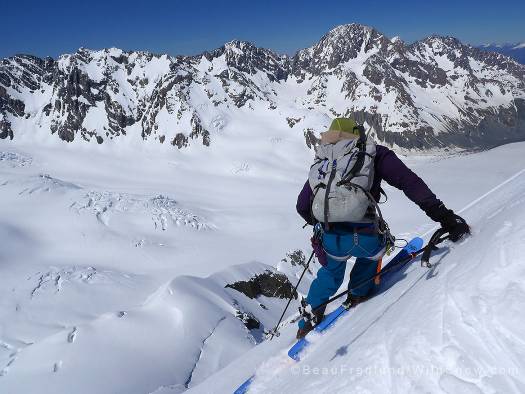
Adam Fabrikant carefully checking out the conditions on the south face of Mt. Green. Photo: B. Fredlund
6. Consider buying (instead of renting) a car if you are traveling around New Zealand for a month or longer. Christchurch has a couple of great resources for this approach: Turner’s Car Auction and the Backpacker’s Car Market. Toyota vans are common, as are Subaru wagons. Both have high resale value, so you might even be able to make some coin off the car when it’s all said and done. Just remember to drive on the left side of the road! And honk often.
7. Freshen up on your glacier travel skills. Much of the alpine in New Zealand is glaciated and broken. While there, plan to wear a harness, carry a rope, have your rescue systems dialed, and route-find carefully around and over crevasses and bergschrunds.
8. Make sure to book your trip during good weather so you can ski huge peaks and big lines instead of sitting in Queenstown drinking Pino Noir.
9. Don’t feed the kea. New Zealand’s native, alpine parrot is an endangered species that needs all the help it can get. And that means not becoming habituated to human handouts (think of them as bears).
9. Steel crampons and technical ice tools are advised. You can get away with aluminum spikes, but if you plan to ski and climb a bunch in the higher glaciated peaks, steel is definitely the way to go.
10. Hit the stairclimber before you go. All that front pointing can murder your calf muscles if you’re not prepared.
11. Ski crampons, ski crampons, ski crampons. I asked one local if he skied with them often, and he said ‘religiously.’
12. Eat heaps of pies (shepherds pies). They’ll get you up the mountain, and it’s what the locals eat. Recommended pie shops are to be found in the towns of Fairlie and Shefield.
13. Walk up and/or down the Tasman Glacier at least once. It’s a great lesson in geology/glaciology, and a way to scout conditions for a number of nice routes.
14. Consider having a go at Mt. Aspiring. The approach up West Matukituki and the French Ridge is a rich overall experience, well worth your time.
15. Buy a SIM card at the airport. They’ll insert it into your smart phone to save you from paying hefty international rates. Also, pick up a plug adapter so you can keep your phones and cameras topped off.
16. Befriend the local hut wardens and guides. You’ll end up with gourmet meals, movie screenings, and more beta than you know what to do with.
17. Don’t be afraid to get your feet wet. Seriously. Get used to fording in your tennies. This applies for the both the braided river scene in the east, and the West Coast bush.
18. When in Wanaka: go to the Kai Whakapai for beers, and Red Star Burger for the blue or the mofo.
19. Pick highly motivated and like-minded individuals to ski and travel with.
Beau Fredlund is a backcountry ski guide and photographer based in Cooke City, Montana. He can be found on Instagram at: @bfredlund, and is the owner and lead guide of Yellowstone Ski Tours, www.yellowstoneskitours.com, a ski guiding service that focuses on leading trips in Yellowstone National Park.

